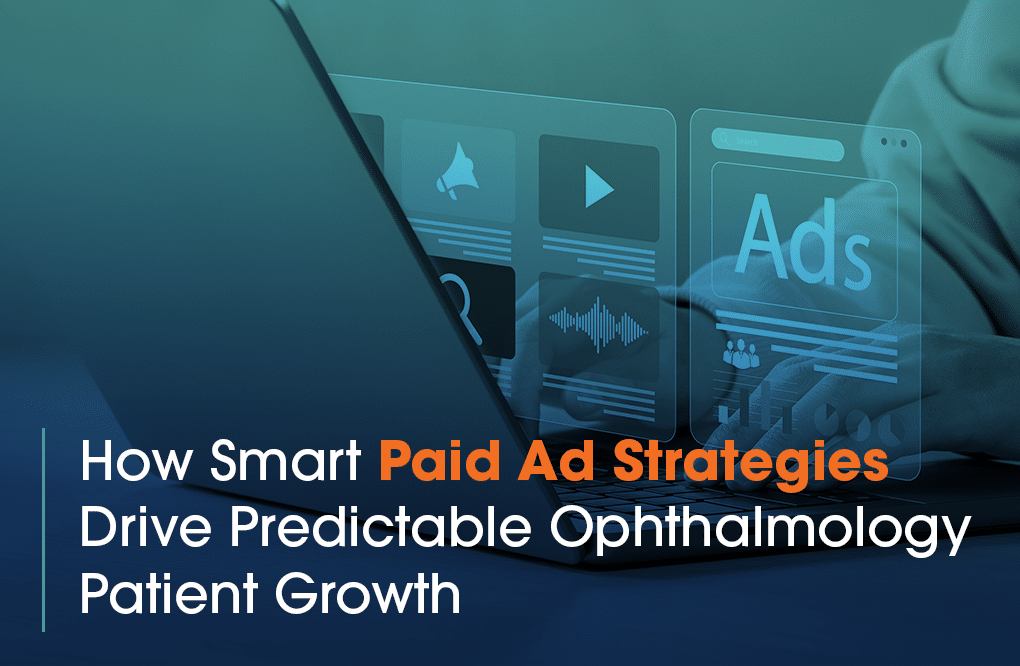Posted on June 29, 2025
How Smart Paid Ad Strategies Drive Predictable Ophthalmology Patient Growth

Despite investing thousands of dollars in advertising each month, many ophthalmology practices watch their patient acquisition costs rise while new patient volume remains stagnant. Meanwhile, some eye care practices consistently generate predictable patient growth from the same advertising platforms.
The key difference lies in how these successful practices approach vision-concerned patients, who require fundamentally different messaging and touchpoints than typical healthcare consumers. Their success stems from understanding one fundamental truth about vision patients that changes everything about effective advertising strategy.
Understanding the Unique Psychology of Ophthalmology Patients
Ophthalmology practices can’t use the same advertising playbook as restaurants or retail stores. Eye care patients face higher psychological stakes because vision is irreplaceable, creating anxiety that standard marketing approaches often miss.
Patients often go through a few distinct phases during their patient journey. During the research phase, patients typically aren’t actively seeking treatment. They might be experiencing subtle vision changes, quietly investigating whether their symptoms warrant professional attention. Alternatively, they might be processing concerning exam findings, causing them to seek reassurance or guidance through their internet searches.
This creates a critical opportunity for practices to establish authority through organic search presence. Practices can accomplish this by creating comprehensive content that directly addresses patient concerns and positions the practice as a trusted resource before patients begin actively seeking providers.
In the next phase, the evaluation phase, patients become active comparison shoppers, analyzing procedures, studying success rates, and conducting extensive vetting to determine which provider they can trust with their sight. This phase can last months, particularly for elective procedures.
The last phase is the commitment phase. This phase involves overcoming final barriers: cost concerns, procedure anxiety, scheduling logistics, and family input.
These phases aren’t linear. Patients frequently cycle between evaluation and commitment multiple times. Successful campaigns recognize this fluid movement and provide relevant touchpoints throughout the entire journey.
How Ophthalmology Practices Can Overcome the Patient Trust Deficit
Ophthalmology practices face a unique trust challenge that other medical specialties don’t encounter. Patients can’t easily evaluate the quality of eye surgery results the way they might assess cosmetic procedures or joint replacements. This creates a decision-making environment where credentials, patient testimonials, and practice reputation carry disproportionate weight.
Successful advertising campaigns address this trust deficit directly by establishing credibility and authenticity. Effective campaigns demonstrate expertise, showcase successful outcomes, and connect with patient concerns on an emotional level.
Choosing the Right Advertising Platforms for Ophthalmology
The highest-performing ophthalmology practices run integrated campaigns across both Google Ads and Meta, recognizing that each platform serves a different purpose in patient acquisition.
Google Ads
Google Ads performs best when targeting specific procedures rather than specific problems. While there’s a time and place for targeting symptoms with search campaigns, by this point in their journey, patients are likely searching for solutions rather than answers to general questions.
Symptom-focused campaigns may generate significant traffic, but are typically not ideal for lead generation. The true strength of Google Ads lies in appearing with the exact result someone is looking for at the precise moment they’re searching for it.
The best-performing campaigns focus on procedure and solution-specific keywords rather than general, question-based queries. This approach captures patients who have moved beyond the research phase and are actively seeking treatment options.
Meta Advertising
Meta’s strength in ophthalmology advertising lies in its ability to reach patients before they begin actively searching for treatment. The platform excels at delivering educational content that builds awareness, addresses common misconceptions, and establishes practice authority over time.
The most effective Meta campaigns for ophthalmology focus on patient education rather than direct promotion. Content addressing common vision concerns, explaining procedure advances, or discussing when to seek treatment performs significantly better than advertisements directly promoting services.
This strategy nurtures patients throughout their research phase, positioning your practice as a trusted authority when they’re ready to move toward treatment decisions.
Implementation Roadmap
The most successful transformations follow a structured approach that minimizes risk while maximizing learning opportunities.
First, it’s important to focus on establishing proper tracking, identifying high-value patient types, and launching focused campaigns targeting the practice’s most profitable procedures. Campaign launches should begin with conservative budgets on proven strategies rather than attempting to test multiple approaches simultaneously. Once foundational campaigns demonstrate consistent performance, budgets can scale, and additional strategies can be layered in.
Next, the optimization phase begins using performance data from foundational campaigns to refine targeting, messaging, and budget allocation. This phase typically reveals unexpected insights about patient behavior, competitive dynamics, and conversion patterns that inform future strategy decisions.
Expansion occurs gradually, adding new campaigns, platforms, or targeting approaches only after existing campaigns achieve stable performance. This methodical approach prevents the common mistake of scaling too quickly and losing the ability to identify which changes drive results.
It’s important to view paid advertising as a systematic approach to predictable patient acquisition. When executed with attention to patient psychology, platform-specific optimization, and continuous improvement processes, paid advertising can become the foundation for sustainable practice growth.
Ready to Transform Your Practice’s Patient Acquisition Strategy?
The practices that achieve this transformation share one common trait: they partner with specialists who understand both ophthalmology patient psychology and digital marketing optimization.
Over the past 25 years, Glacial Multimedia has specialized in refining digital marketing strategies specifically for ophthalmology, ENT, and other medical specialties. Through thousands of campaigns and millions in ad spend analysis, our team of specialists has identified the precise strategies that separate practices achieving significant growth from those struggling to break even on their advertising investments.
If you’re ready to discover which specific approaches will work best for your practice and patient population, let’s schedule a conversation to review your current results and identify your highest-impact opportunities.
